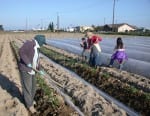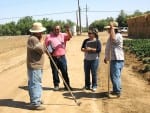California’s diversity isn’t just seen in its crops, but also in the people who grow them.
- Hmong farmers in Fresno County. Photo courtesy of Michael Yang, UCCE
- Aaron Pamma, Sutter County farmer
- 2014 Sikh Parade in Yuba City. All other photos courtesy of DPR
- DPR fieldworker training program, Merced County.
In the fields, you’ll hear workers speaking not only Spanish and English, but Hmong, Punjabi and many other languages.
The California Department of Pesticide Regulation (DPR) wants all workers who handle pesticides to know how to use such products safely. The Department also wants people who work in and around treated fields to know about the dangers of pesticides at the workplace and how to protect themselves from pesticide exposure. That’s why DPR has translated leaflets, videos and other materials about pesticide safety, produced by scientists at DPR, into different languages including Spanish and Punjabi. You can see the Pesticide Safety Information Series (PSIS) leaflets here.
California’s county agricultural commissioners (CACs) and the UC Cooperative Extension (UCCE) partner with DPR to spread the message about using pesticides safely. Their collective efforts help advance environmental justice, protecting all Californians — regardless of race, age, culture, income, or geographic location — from adverse effects of pesticides.
The PSIS leaflets are mentioned during bilingual pesticide safety presentations, like the ones given by DPR inspector Fidel Perez. He’s a six-year veteran of the Department who works in West Sacramento. Perez carries out translations for Spanish-speakers, doing about three presentations per year in Yuba and Sutter Counties. CAC staffers give out the leaflets upon request and during inspections.
“I think it is important to provide outreach in a native tongue,” Perez said, adding that having someone to talk to in their language puts the working community at ease. “It’s a great tool to be able to provide.”
Punjabi-American farmers grow Sutter County’s fruit, nuts
Yuba City has one of the largest Punjabi-American communities in North America. Many are farmers, who grow various orchard crops including peaches and prunes.
“We were raised in farming – it was something we did since I was born. It’s just in our blood, basically,” said Sutter CAC agricultural biologist Hardeep Bains, who comes from a local farming family.
Fluent in Punjabi, Bains translates at pesticide safety events in Yuba City, covering topics such as spraying safely and proper personal protective equipment (such as wearing coveralls, gloves and goggles) when handling pesticides. Bains goes out to translate in the field about three or four times per year.
“We try to do whatever we can … the problem is just getting out to some people,” Bains said. “A lot of them don’t know that we can go out and do that.”
Bains said it’s mostly the older generation who need Punjabi-language resources.
“A lot of the younger generation isn’t really working in the fields,” Bains said. “It’s hard to find young farmers anymore that want to do it.”
Chico State Punjabi Club president Aaron Pamma, 20, is among the exceptions. He farms almonds, peaches, pistachios, prunes and walnuts in Butte and Sutter Counties with his father and grandfather. Pamma spent his winter break from college in theorchards, pruning trees. He said club members from Northern California often come from farming families, but not those from the Bay Area.
“They’re so ecstatic to see a tractor, it’s kind of funny,” Pamma said.
Fresno County’s Hmong small farmers
Fresno County has the largest concentration of Hmong farmers in the U.S., who grow specialty crops like daikon, long beans lemongrass and sugar cane.
Michael Yang, the Small Farms and Specialty Crops Hmong Agricultural Assistant for UCCE in Fresno County, hosts a weekly radio show about Central Valley agriculture on 900 AM KBIF, where he announces news and trainings.
“The Bagrada bug is a very serious issue right now,” Yang said of the invasive species’ impact on Hmong farmers.
Some Hmong families don’t like to use pesticides, he said, and will ask for an organic solution.
“They would come to our office and ask what types of pesticides are registered for the crop they want to use,” Yang said. “You have to make sure you know all the technology, chemicals … unlike back then in Southeast Asia.”
Fresno Deputy CAC Stace Leoni said they have several staffers who can speak different Hmong dialects, along with many multilingual biologists. Translators are sometimes needed to share information about permits or farmers markets, she said.
Developing more resources
DPR has distributed more than 30,000 wallet-sized laminated cards for Spanish-speaking field workers that give a toll-free number to call if they suspect pesticides have made them sick. The Department’s Spanish radio and television public service announcements (PSAs,) about the toll-free line were broadcast in 2013 and 2014.
“People told us that they like more PSAs in Spanish, on radio and television,” said DPR environmental scientist Martha Sánchez, who travels statewide doing outreach events throughout the year.
Meanwhile, the Fresno CAC is working to update some continuing education training modules and make them multilingual, Leoni said.
“We are revamping them to make them more current,” Leoni said, adding that the topics are field worker safety, personal protective equipment, and how to interpret a label. The county plans to translate the modules into Spanish, Hmong and Punjabi.













